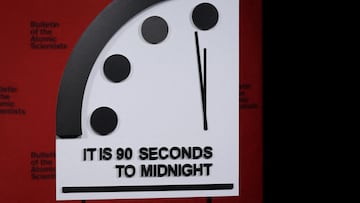‘Doomsday Clock’ is as close to midnight as ever before: what does it mean?
Life on Earth is facing the very real threats of war and climate change, among other factors, as scientists count down its demise.

Quick! Do everything you wanted to do in life and do it really quickly. There’s just a minute and a half till the end of the world. Wait, what? That’s just a relative timescale to see the lifespan of our planet through a different lens? Ah, then we can relax, no need to stockpile the tinned mango slices just yet. Take that silly hard hat off as well, you look ridiculous.
Well, don’t relax too much, say the atomic scientists that have set what is known as the ‘Doomsday Clock’ closer to midnight than ever before. On Tuesday they advised that threats of war, climate volatility and nuclear spending, all exacerbated by Russia, the USA, China, North Korea among others, as well as mentioning Israel’s continued attack on Palestinian civilians and even the development of AI.
Today, the Bulletin’s Science and Security Board once again sets the #DoomsdayClock at 90 seconds to midnight.
— Bulletin of the Atomic Scientists (@BulletinAtomic) January 23, 2024
Humanity continues to face an unprecedented level of danger.
Read the full statement: https://t.co/PowB7RkzXw pic.twitter.com/aRyF2ZX3wB
What is the Doomsday Clock?
The ‘Doomsday Clock’ was created by the Bulletin of the Atomic Scientists to illustrate how close humanity has come to the end of the world. Midnight on this clock marks the theoretical point of annihilation. The clock’s hands are moved closer to or further away from midnight based on scientists’ reading of existential threats at a particular time.
The latest move has it at just 90 seconds to midnight, the closest it ever has been in history.
“The use of nuclear weapons by Russia in that conflict remains a serious possibility... Iran continues to enrich uranium to close to weapons grade while stonewalling the International Atomic Energy Agency on key issues... North Korea continues building nuclear weapons and long-range missiles.” the organisation said in a statement regarding nuclear threats to the planet.
What factors influence the Doomsday Clock?
A Chicago-based non-profit organisation, the bulletin updates the clock’s time annually based on information regarding catastrophic risks to the planet and humanity. The organisation’s board of scientists and other experts in nuclear technology and climate science, including 13 Nobel Laureates, discuss world events and determine where to place the hands of the clock each year.
Apocalyptic threats reflected by the clock include politics, weapons, technology, climate change and pandemics. The clock had been set to 100 seconds to midnight since 2020, which was already the closest it had ever come to midnight. Last year, the board said the war in Ukraine had also heightened the risk that biological weapons could be deployed if the conflict continued. This time around, it was Israel and Palestine that was under the spotlight:
“The war in Gaza between Israel and Hamas has the potential to escalate into a wider Middle Eastern conflict that could pose unpredictable threats, regionally and globally.”
Today, the Bulletin's Science and Security Board moved the #DoomsdayClock to #90SecondsToMidnight.
— Bulletin of the Atomic Scientists (@BulletinAtomic) January 24, 2023
To learn more about this decision, read the 2023 Doomsday Clock Statement: https://t.co/13Y7tZUnZy pic.twitter.com/sVNGHdasGU
AI seen as a threat to humanity
Another intriguing addition to the list of potential threats was that of AI , with the group saying that there is “great potential to magnify disinformation and corrupt the information environment on which democracy depends. AI-enabled disinformation efforts could be a factor that prevents the world from dealing effectively with nuclear risks, pandemics, and climate change”.
“Fortunately”, the statement continued, “many countries are recognizing the importance of regulating AI and are beginning to take steps to reduce the potential for harm. These initial steps include a proposed regulatory framework by the European Union, an executive order by President Biden, an international declaration to address AI risks, and the formation of a new UN advisory body”.
Did Einstein invent the Doomsday Clock?
A legend of the science world, Albert Einstein, was part of the group of atomic scientists that created the clock in 1947. They had also worked on the Manhattan Project to develop the world’s first nuclear weapons during World War Two. Back then, more than 75 years ago, it began ticking at seven minutes to midnight.
Related stories
The clock was furthest from ‘doomsday’ in 1991, as the Cold War ended and the United States and Soviet Union signed a treaty that substantially reduced both countries’ nuclear weapons arsenals. Then it was at 17 minutes to midnight. Oh how different things look today.
For all the latest news from around the world, check out our dedicated news section.

